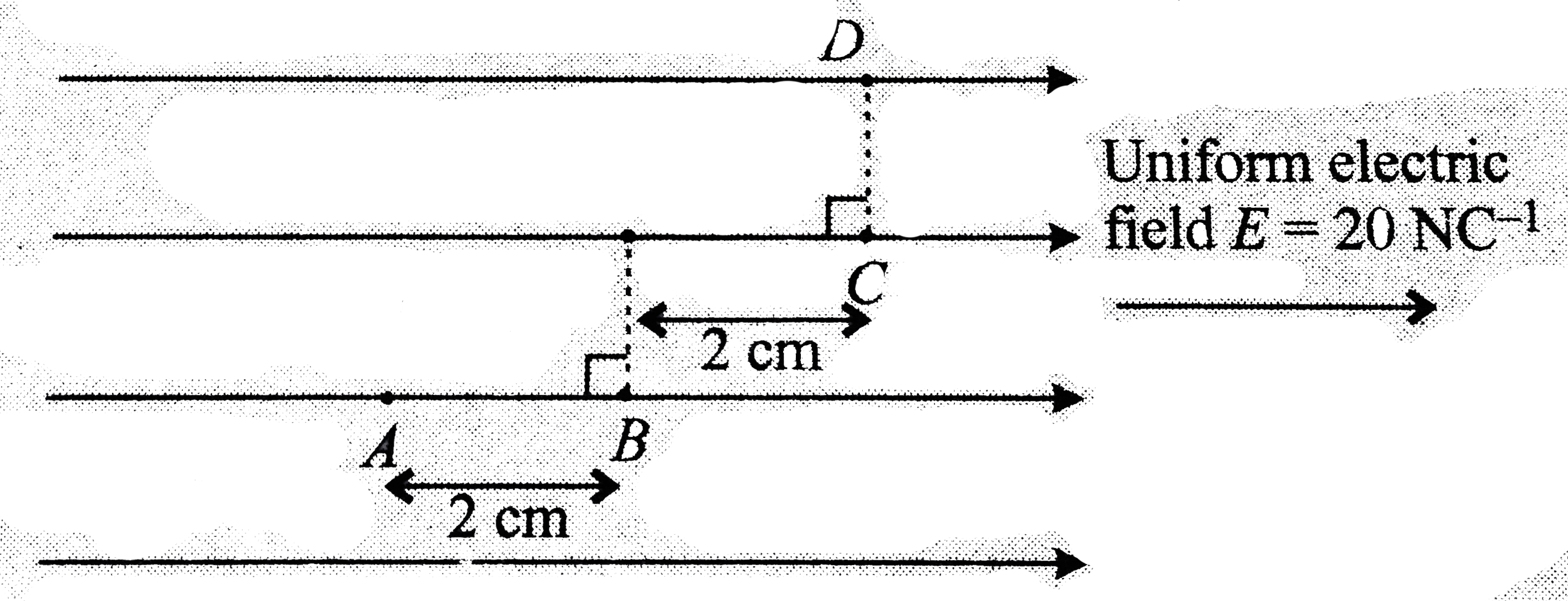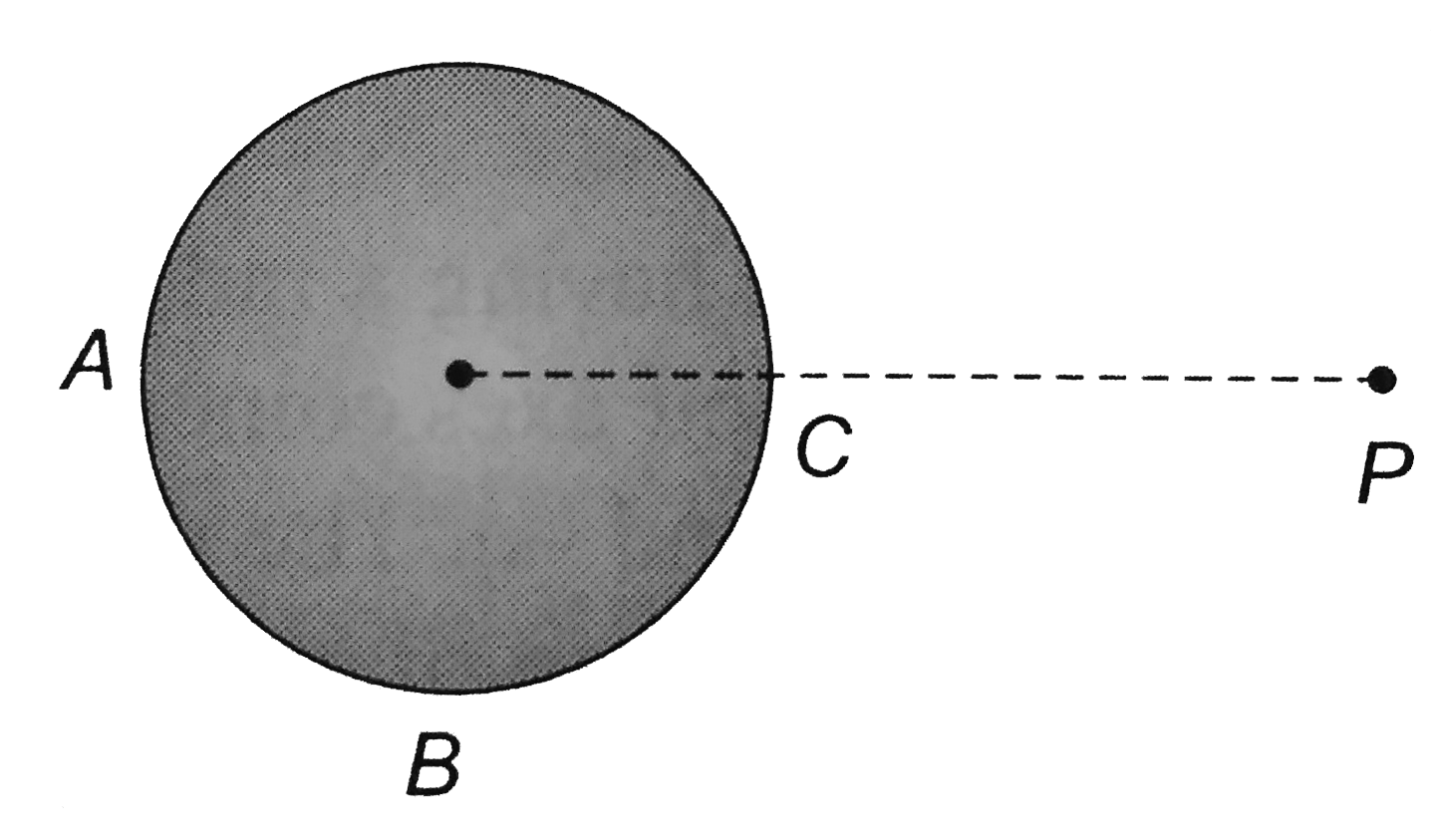Find out the following
a. VA−VB
b. VB−VC
c. VC−VA
d. VD−VC
e. VA−VD
f. Arrange the order of potential for points (A, B,C and D).
 .
.
(i) The potential difference between two points in electric field is
|ΔVAB|=−→E.−−→AB=Edcosθ=E.d
=Ed=20×2×10−2=0.4
So VA−VB=0.4V
Negative because in the direction of electric field, potential always decreases.
(ii) |ΔVBC|=Ed=20×2×10−2=0.4
d is the distance between the equipotential passing through
B and C, so VB−VC=0.4V
(iii) |ΔVCA|=Ed=20×4×10−2=0.8
So VC−VA=−0.8V
Negative because in the direction of electric field, potential always decreases.
(iv) |ΔVDC|=Ed=20×0=0
So VD−VC=0
Because the effective distance between D and C is zero. Also potential difference between C and D is zero as both the points lie on same equipotential.
(v) |ΔVAD|=Ed=20×4×10−2=0.8
Here d is the distance between equipotential pasing through A and D.
So VA−VD=0.8V
Because in the direction of electric field, potential always decreases.
(vi) The order of potential is
VA>VB>VC=VD.
Topper's Solved these Questions
- ELECTRIC POTENTIALBOOK - CENGAGE PHYSICS ENGLISHCHAPTER - ELECTRIC POTENTIALEXERCISE - Exercise 3.2
9 Videos
- ELECTRIC POTENTIALBOOK - CENGAGE PHYSICS ENGLISHCHAPTER - ELECTRIC POTENTIALEXERCISE - Exercise 3.3
9 Videos
- ELECTRIC POTENTIALBOOK - CENGAGE PHYSICS ENGLISHCHAPTER - ELECTRIC POTENTIALEXERCISE - Examples
9 Videos
- ELECTRIC FLUX AND GAUSS LAWBOOK - CENGAGE PHYSICS ENGLISHCHAPTER - ELECTRIC FLUX AND GAUSS LAWEXERCISE - MCQ s
38 Videos
- ELECTRICAL MEASURING INSTRUMENTSBOOK - CENGAGE PHYSICS ENGLISHCHAPTER - ELECTRICAL MEASURING INSTRUMENTSEXERCISE - M.C.Q
2 Videos
Similar Questions
Find out following

(i) VA−VB (ii) VB−VC (iii) VC−VA (iv) VD−VC
(v) VA−VD (vi) Arrange the order of potential for points A, B, C and D.
View SolutionIn the uniform electric field shown in figure, find :
a. VA−VD
b. VA−VC
c. VB−VD
d. VC−VD

View SolutionIn the given circuit find the |VA−VB| where VA,VB are electric potentials at the points A and B.

View SolutionIn uniform electric field E=10N/C, find

a. VA−VB , b. VB−VC
View SolutionA hollow conducting sphere is placed in an electric field produced by a point charge placed at P as shown in figure.
Let VA,VB,VC be the potentials at points A,BandC respectively. Then

View SolutionA hollow conducting sphere is placed in an electric field produced by a point charge placed at P as shown in figure.
Let VA,VB,VC be the potentials at points A,BandC respectively. Then

View SolutionA hollow conducting sphere is placed in an electric field produced by a point charge placed at P as shown in figure.
Let VA,VB,VC be the potentials at points A,BandC respectively. Then

View SolutionA uniform electric field pointing in positive x-direction exists in a region. Let A be the origin, B be the point on the x-axis at x=+1cm and C be the point on the y-axis at y=+1cm. then the potential at the points A,B and C satisfy
a. VA<VB, b. VA>VB c. VA<VC d. VA>VC
View SolutionFigure shows four points A, B, C and D in uniform electric field →E. The line AB and CD are perpendicular and BC and AD are parallel to the field lines. If VA,VB,VCandVD are electric potential at A, B,C,D choose the correct option.

View SolutionThe figure shows a arrangement of capacitors and a battery.

The potential of the points B and D are (if VC=0)
View Solution
